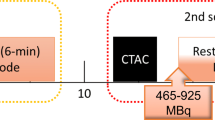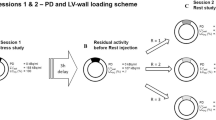Abstract
Purpose
Misalignment of low-dose-CT used for attenuation correction (AC) may cause artifacts in cardiac-PET–CT. The aim was to evaluate incidence and severity of misalignment and its quantitative effects on regional myocardial 82Rb-distribution.
Methods
Rest/dipyridamole 82Rb-perfusion-PET–CT studies of 92 consecutive patients were analyzed for misalignment. Two different scanning protocols were employed: the first 57 patients had separate CTs for rest and stress PET. The following 35 patients had one CT at rest, used for AC of rest and stress PET. Misalignment was visually scored on a five-point scale (0 = no, 1 = minimal, 2 = mild, 3 = moderate, and 4 = severe). In five representative patients with normal perfusion and low probability of disease, 95 polarmaps were created by shifting CT vs PET prior to reconstruction of attenuation-corrected data sets using dedicated software (three dimensions of space; magnitude of shifts, 5, 10, 14 mm).
Results
PET/CT -misalignment was detected in 60% of rest and 67% of stress studies. Alignment for rest was better than that for stress (0.7 ± 0.7 vs 1.0 ± 0.9, P = 0.03). Comparison of the two protocols revealed no effect on the alignment of the stress study (1.0 ± 0.9 vs 1.0 ± 0.9, P = 0.9). Quantitatively, the largest individual effect of any artificial misalignment was a 25% reduction of relative 82Rb uptake. With a shift of 1 cm, the largest effect in an individual was a 19% decrease. Anterior wall was most frequently influenced by misalignment, but changes of uptake also occurred in all other segments.
Conclusions
Misalignment between CT and PET in cardiac-PET–CT influences regional tracer distribution in multiple segments. Repeated CT imaging after dipyridamole does not improve alignment. These results emphasize the need for strategies to improve coregistration in clinical imaging protocols.



Similar content being viewed by others
References
Yoshinaga K, Chow BJ, Williams K, Chen L, deKemp RA, Garrard L, et al. What is the prognostic value of myocardial perfusion imaging using rubidium-82 positron emission tomography? J Am Coll Cardiol 2006;48 5:1029–39.
Bateman TM, Heller GV, McGhie AI, Friedman JD, Case JA, Bryngelson JR, et al. Diagnostic accuracy of rest/stress ECG-gated Rb-82 myocardial perfusion PET: comparison with ECG-gated Tc-99m sestamibi SPECT. J Nucl Cardiol 2006;13 1:24–33.
Tarakji KG, Brunken R, McCarthy PM, Al Chekakie MO, Abdel-Latif A, Pothier CE, et al. Myocardial viability testing and the effect of early intervention in patients with advanced left ventricular systolic dysfunction. Circulation 2006;113 2:230–7.
Sampson UK, Dorbala S, Limaye A, Kwong R, Di Carli MF. Diagnostic accuracy of rubidium-82 myocardial perfusion imaging with hybrid positron emission tomography/computed tomography in the detection of coronary artery disease. J Am Coll Cardiol 2007;49 10:1052–8.
Dorbala S, Hassan A, Heinonen T, Schelbert HR, Di Carli MF. Coronary vasodilator reserve and Framingham risk scores in subjects at risk for coronary artery disease. J Nucl Cardiol 2006;13 6:761–7.
Chow BJ, Wong JW, Yoshinaga K, Ruddy TD, Williams K, deKemp RA, et al. Prognostic significance of dipyridamole-induced ST depression in patients with normal 82Rb PET myocardial perfusion imaging. J Nucl Med 2005;46 7:1095–101.
McCord ME, Bacharach SL, Bonow RO, Dilsizian V, Cuocolo A, Freedman N. Misalignment between PET transmission and emission scans: its effect on myocardial imaging. J Nucl Med 1992;33 6:1209–14.
Loghin C, Sdringola S, Gould KL. Common artifacts in PET myocardial perfusion images due to attenuation-emission misregistration: clinical significance, causes, and solutions. J Nucl Med 2004;45 6:1029–39.
Koepfli P, Hany TF, Wyss CA, Namdar M, Burger C, Konstantinidis AV, et al. CT attenuation correction for myocardial perfusion quantification using a PET/CT hybrid scanner. J Nucl Med 2004;45 4:537–42.
Martinez-Moller A, Souvatzoglou M, Navab N, Schwaiger M, Nekolla SG. Artifacts from misaligned CT in cardiac perfusion PET/CT studies: frequency, effects, and potential solutions. J Nucl Med 2007;48 2:188–93.
Osman MM, Cohade C, Nakamoto Y, Marshall LT, Leal JP, Wahl RL. Clinically significant inaccurate localization of lesions with PET/CT: frequency in 300 patients. J Nucl Med 2003;44 2:240–3.
Osman MM, Cohade C, Nakamoto Y, Wahl RL. Respiratory motion artifacts on PET emission images obtained using CT attenuation correction on PET–CT. Eur J Nucl Med Mol Imaging 2003;30 4:603–6.
Chin BB, Nakamoto Y, Kraitchman DL, Marshall L, Wahl R. PET–CT evaluation of 2-deoxy-2-[18F]fluoro-D-glucose myocardial uptake: effect of respiratory motion. Mol Imaging Biol 2003;5 2:57–64.
Gould KL, Pan T, Loghin C, Johnson NP, Guha A, Sdringola S. Frequent diagnostic errors in cardiac PET/CT due to misregistration of CT attenuation and emission PET images: a definitive analysis of causes, consequences, and corrections. J Nucl Med 2007;48 7:1112–21.
Goetze S, Wahl RL. Prevalence of misregistration between SPECT and CT for attenuation-corrected myocardial perfusion SPECT. J Nucl Cardiol 2007;14 2:200–6.
Matsunari I, Boning G, Ziegler SI, Kosa I, Nekolla SG, Ficaro EP, et al. Effects of misalignment between transmission and emission scans on attenuation-corrected cardiac SPECT. J Nucl Med 1998;39 3:411–6.
Beyer T, Antoch G, Blodgett T, Freudenberg LF, Akhurst T, Mueller S. Dual-modality PET/CT imaging: the effect of respiratory motion on combined image quality in clinical oncology. Eur J Nucl Med Mol Imaging 2003;30 4:588–96.
Goerres GW, Kamel E, Heidelberg TN, Schwitter MR, Burger C, von Schulthess GK. PET–CT image co-registration in the thorax: influence of respiration. Eur J Nucl Med Mol Imaging 2002;29 3:351–60.
Le Meunier L, Maass-Moreno R, Carrasquillo JA, Dieckmann W, Bacharach SL. PET/CT imaging: effect of respiratory motion on apparent myocardial uptake. J Nucl Cardiol 2006;13 6:821–30.
Nehmeh SA, Erdi YE, Pan T, Pevsner A, Rosenzweig KE, Yorke E, et al. Four-dimensional (4D) PET/CT imaging of the thorax. Med Phys 2004;31 12:3179–86.
Pan T, Mawlawi O, Nehmeh SA, Erdi YE, Luo D, Liu HH, et al. Attenuation correction of PET images with respiration-averaged CT images in PET/CT. J Nucl Med 2005;46 9:1481–7.
Goetze S, Brown TL, Lavely WC, Zhang Z, Bengel FM. Attenuation correction in myocardial perfusion SPECT/CT: effects of misregistration and value of reregistration. J Nucl Med 2007;48 7:1090–5.
Acknowledgements
Dr. Lautamäki is supported by grants from The Finnish Cardiac Research Foundation, The Finnish Medical Foundation, and The Instrumentarium Foundation for Science and by the Bracco/SNM Research Fellowship in Cardiovascular Molecular Imaging kindly provided by the Cardiovascular and Radiopharmaceutical Sciences Councils, the Society of Nuclear Medicine, and Bracco.
Author information
Authors and Affiliations
Corresponding author
Rights and permissions
About this article
Cite this article
Lautamäki, R., Brown, T.L.Y., Merrill, J. et al. CT-based attenuation correction in 82Rb-myocardial perfusion PET–CT: incidence of misalignment and effect on regional tracer distribution. Eur J Nucl Med Mol Imaging 35, 305–310 (2008). https://doi.org/10.1007/s00259-007-0607-y
Received:
Accepted:
Published:
Issue Date:
DOI: https://doi.org/10.1007/s00259-007-0607-y




